THE REAL 'DAD'S ARMY'
How Workington Was Defended During WWII.
In the four days following Mr Anthony Eden's call for volunteers to form a Citizen army on 14th
May 1940, over One Thousand Workington men had applied to join it. The 'L.D.V.', or Local
Defence Volunteers, were formed into a group - 'E' Group - organised by the local territorial
association, covering the Workington, Cockermouth and Maryport area.
At a meeting held in the Commercial Hotel on 17th May that year, two Workington companies were formed:
One from the Workington Iron and Steel Company and one from the rest of the town. Drilling took place
forthwith in the drill-hall on Edkin Street (now under St. John's Precinct), and the men
took up arms consisting of dummy rifles (for the steel-works division), assorted firearms collected by the
police, and molotov cocktails.
Uniforms - of sorts - were issued in July 1940, but it was a while before any of it arrived that
happened to fit!
American calibre .300 rifles started to arrive about the same time, eventually being supplemented by
ammunition to fire from them..... Supplies gradually trickled in; Tommy-guns, Browning automatic rifles,
Browning heavy machine-guns, Type 36 hand-grenades and plentiful, better-fitting uniforms.
The L.D.V, then, consisted of about 1200 volunteers grouped thus: Workington Iron and Steel Works; Workington town; Cockermouth, and Maryport. 'E' - group was divided into two battalions in July 1940; the 4th Battalion based at Cockermouth and the 5th Battalion based at Workington. The L.D.V. was retitled the "Home-Guard at this time. Local battalions were then deemed to be affiliated to their county regiments and
allowed to wear the county regiment insignia. The 5th battalion was thus affiliated to the
Border Regiment. In 1941 the Home-Guard began to be organised in the same manner as the
regular army.
The Workington battalion was now organised into six companies, a coast-battery detachment and Signals and
Intelligence sections :
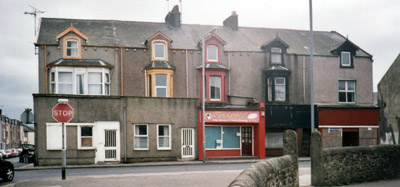 Battalion Headquarters were initially located in Workington's Drill-Hall, then moved to No:5, Senhouse Terrace on Station Road when the 8th Battalion of the Border Regiment took over the Drill-Hall. BHQ was moved to more suitable premises in March 1942, taking up residence in the Wesleyan School behind the Methodist Church in South William St and staying there until stand-down in 1944. 'C'-Company continued to use No:5 Senhouse Terrace as a company office and Quartermaster's Stores.
Battalion Headquarters were initially located in Workington's Drill-Hall, then moved to No:5, Senhouse Terrace on Station Road when the 8th Battalion of the Border Regiment took over the Drill-Hall. BHQ was moved to more suitable premises in March 1942, taking up residence in the Wesleyan School behind the Methodist Church in South William St and staying there until stand-down in 1944. 'C'-Company continued to use No:5 Senhouse Terrace as a company office and Quartermaster's Stores.
.
'B' - Company was split into two, with the Harrington division becoming known as 'F'
- Company. Rifle-ranges were constructed at Oldside shore and elsewhere, to ease the strain on
the Winscales rifle-range. A grenade-range was also constructed on Oldside shore.
Equipment now began to flow in. Spigot-mortars, Sten-guns, Bayonets, various sorts of grenades,
Smith-guns, cloth battledress, gas-masks, gas-capes and tin-hats. Ultimately, the battalion was kitted
out with radio-telephones, two vans, two cars and several motor-cycles. Training and function
developed from 'Para-shots' scouring the countryside for enemy parachutists and armed ad-hoc, to
a highly-trained body of men putting up road-blocks, and eventually strong nodal points guarding lines of
communication and important installations.
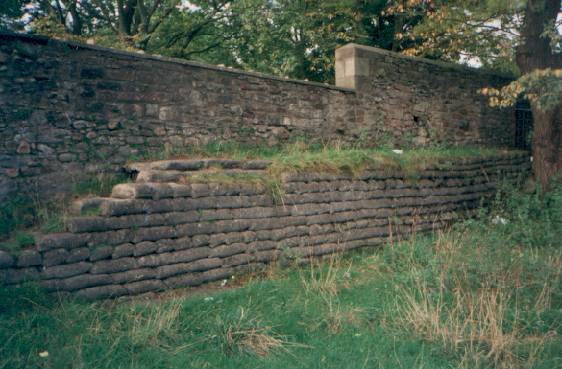
In October 1942, a Local Defence Committee was set up in Workington to
Bring together the Army, Navy, Home-Guard, Police and Civil Defence into
regular consultation, thus co-ordinating all defence practicalities for the
area.
It was decided by a higher committee that the town of Workington be held as a 'Nodal-Point' and be surrounded by a series of defended localities.
A platoon would be in charge of each locality and the
Marsh would be designated a 'Keep' where all platoons (Except the coastal gunners) would
withdraw to to fight - if necessary - to the last....
There were three areas of high importance which were to be strongly defended. The
Moss-Bay Iron and Steelworks, which produced munitions and ball-bearings; The High-Duty
Alloys factory at Distington - a 'Shadow factory' - producing aircraft components;
and the Magnesium works on Harrington shore. A similar scheme had
been set up to defend the dock. Two mobile Home-Guard (henceforth referred to as HG)
columns were specially trained to re-inforce any threatened installation or
industrial area. 'B'-mobile column, based in Workington (4 battle
platoons) and 'D'-mobile column, based at Clifton (3 battle
platoons).
As outlined on a map of the town on the 3rd August 1941 by A. B. Cooper, A.M.I.C.S., Borough Engineer and
Surveyor. Despite the details found as being on record, I have no evidence that any of
these structures (other than the pill-box at Castle Gardens) were actually constructed!
The town of Workington was to be blocked off to the enemy at the following strategic points, by a
combination of pill-boxes and road blocks manned by the Workington Home-Guard. The numbers used in
the description reflect the numbers as marked on the original map. Because of the changes in road
layout and building works post-1941, I have added, where necessary, contemporary means of identifying
the location in brackets. Each road-block had a covering pill-box in the immediate vicinity
- SIDDICK (1): Pill-box at the point where the old RNAD railway line leaves Siddick Junction and
crosses over the main A596 trunk road. Sited to the west of the road and the east of the old railway
in the cleft of the embankment.
- OLDSIDE (2): Road-barrier across the A596 trunk road where the 'Thermal Syndicate'
factory was located. (At a point where entrance is gained to Dunmail Park.)
- NORTHSIDE (3): Pill-box made from converting a room of a house, on the west side of the junction of the
New Bridge road, the A596 and the road to the docks. (The house concerned was the end one of a terrace of
iron-workers cottages, demolished in the late 1960's. It is now part of the road-junction.)
- WORKINGTON BRIDGE (4): Pill-box made from converting a room of the toll-bar cottage at the foot
of Calva Brow.
- WORKINGTON BRIDGE (5): Road-barrier on the Seaton end of Workington Bridge.
N.B: The photograph above shows HG defences - as remembered by a contamporary - at the other
end of the bridge, looking westwards across it. Evidence still remains of this.
- STAINBURN ROAD (6): Road-barrier on the A597 at the foot of Tannery brow, just west of the remains
of Cuckoo Arch. (Between the rems. of Cuckoo Arch and the Southfield - old Grammar School - entrance,
on A66.)
- STAINBURN ROAD (7): Pill-box in the field below 'Stanbeck House' and south of the A597.
(About where Stanbeck guest-house garden is.)
- CASTLE GARDENS (8): Pill-box in the field behind the wooded section, to the north-east of the
southern-most bend. (The bend to the left when approaching from Whitehaven). Equidistant between
the culvert over Eller Beck and the kennels/cattery. The base of this pill-box is all that is left.
- CASTLE GARDENS (9): Road-barrier across the A596 whitehaven road, just on the south side of the
culvert over Eller Beck.
- MOSS BAY (10): Pill-box at the west side of the B5296, north of the railway over bridge (now demolished),
and just before the start of the terraced houses on the left (as if approaching from Salterbeck).
- MOSS BAY (11): Road-barrier across the B5296 Harrington road, just to the north side
of the railway over bridge (now demolished).
The table below outlines weapons distributed to the Workington Home-
Guard battalions:
| |
TOTAL |
A |
B |
C |
D |
E |
F |
HQ. |
| 2-Pdr. Anti-Tank Guns |
4 |
|
1 |
|
1 |
2 |
|
|
| Smith Guns |
5 |
|
2 |
1 |
2 |
|
|
|
| Spigot Mortars |
22 |
4 |
6 |
4 |
|
6 |
2 |
|
| Browning Medium Machine-Guns |
19 |
4 |
4 |
2 |
2 |
7 |
|
|
| Browning Automatic Rifles |
48 |
12 |
9 |
6 |
6 |
9 |
6 |
|
| Discharger Cup Rifles |
105 |
24 |
24 |
18 |
9 |
15 |
15 |
|
| Rifles .300 |
832 |
161 |
196 |
125 |
105 |
118 |
93 |
34 |
| Rifles .22 |
16 |
3 |
3 |
2 |
3 |
3 |
2 |
|
| Boys Anti-Tank Rifles |
19 |
3 |
6 |
3 |
4 |
3 |
|
|
| Sten Guns |
575 |
109 |
124 |
97 |
61 |
91 |
70 |
23 |
| Lewis Guns |
3 |
|
|
1 |
1 |
|
|
1 |
| Northover Projectors |
11 |
2 |
2 |
2 |
2 |
|
3 |
|
| Marlin Anti-Aircraft Machine-Guns |
8 |
|
|
|
|
8 |
|
|
| 20mm Hispano A.A Machine-Guns |
27 |
18 |
|
|
|
9 |
|
|
Interestingly, although HG defence plans were meticulously laid out, few
actual defence works were erected, apart from on the works of the three companies
mentioned above and the dock. My Father (ex-'B'-Company) remembers
a sort of barricade device in Murray Road, near the railway bridge. It consisted
of oil-drum type blocks in a 'Vee' formation. He also remembers the
road-block mentioned in my Inland anti-invasion
defences list between Broughton cross and Bridgefoot, on the A597; a 'chicane'
device built to slow traffic right down.
HG parades became compulsory in 1941 and men who had volunteered previously
were given until February 1942 to accept the conditions or resign from the HG.
Very few men resigned and more, in fact, were drafted into the HG by the
Ministry of Labour.
Mobilisation of the Home-Guard in an emergency was effected by means of a 'Cascade'
system; Certain Officers and men called upon others, who - in turn - called others
out. This system was preferred over electrical alarms and
air-raid sirens; a means of rapid
mobilisation which had previously been considered and rejected. Men employed by the
companies described above were mobilised by a works local alarm system.
Change of Role:
In 1944 the threat of invasion had receeded. The threat of air-attack, however,
remained as strong as ever. An instruction was received to the effect that all
HG in Workington were to actively assist the Civil Defence Service in the event of
an air-attack. Should an air-attack occur, all HG currently dispersed were to
report to their Company HQ, to be called upon to assist the Civil Defence
services. Lectures in Civil Defence were given to all ranks of HG.
In early 1944, it was decided to convert 'A' (Workington
Iron and Steel Company) and 'E' (High-Duty-Alloys) companies into
light Anti-Aircraft units, armed with 20mm AA Hispano guns. They were still part of the
HG battalion, but received training from the 14th AA area 'M'
Regiment Royal Artillery at Liverpool. Both companies were placed under
tactical command of the 14th (AA) RA.
Most of the many excercises undertaken were in testing the defences of the High-Duty Alloy
plant at Distington; this being regarded by higher military authority as the
most important installation in the area (gas for which was, however, provided
by the Workington Iron and Steel Company!).
In 1943, numerous Women Auxiliaries enrolled with the battalion. Uniforms
for Women were difficult to obtain and so they were issued with HG badges.
They were largely employed on administrative duties and answering telephones
on tactical excercises. Many proved to be crack .22 rifle shots and were trained
as First-Aiders, Signallers and Drivers. A company of Army Cadets was also
attached to the battalion, consisting of three platoons:
- A platoon attached to Workington Town Boys' Club;
- A platoon attached to the Roman Catholic Boys' Club; and -
- A Town platoon.
Air-Raid Precautions.
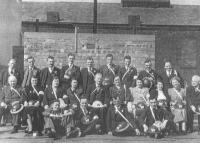 In addition to the Home-Guard, the town was patrolled at night by Air-Raid Wardens,
seeking out those dodgy black-out curtains and urging errant householders
to 'Put that bl**dy light out!'.
In addition to the Home-Guard, the town was patrolled at night by Air-Raid Wardens,
seeking out those dodgy black-out curtains and urging errant householders
to 'Put that bl**dy light out!'.
Shown here is a picture of Workington's 'Marsh and Quay' Air-Raid Precautions
wardens, posing for a group photo outside their warden's post. By clicking on the image, a
larger (88kb) image will appear with all their names underneath (all except three, whose names
I haven't found out yet).
There was a similar Wardens' post to this at Moss Bay, behind the Moss Bay Hotel (now
demolished).
Like every other town, city and conurbation during WWII, Workington had a supply of Static Water Tanks as an emergency water supply - or EWS - which were used for fighting fires. Tanks in Workington were located at the following places:
- Behind Lawson Street on the Quay
- Hagg Hill
- Gordon Street
- Queen Street - next to the 'Tin Mission'.
- St. John's Church
- St. Michael's Road
- Salterbeck Road (alongside AFS Fire-Station)
A Civil-Defence exercise in 1942 saw tranches of hoses stretched all the way along Washington Street, extending further along Bridge Street and into the mill stream by the soapery from where the water was extracted. During the course of the war, pipes from the Gordon Street EWS ran down station road, providing a suitable hazard for tripping up over during the blackout, despite occasional white markings!
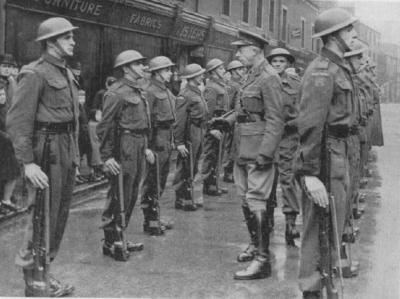
|
| ABOVE: Stand-down parade, Finkle St. Workington. Guard of Honour
formed by 'A' -Company and inspected by Col. T. Dix-Perkin, Sub-District
Commander. |
In September 1944, the Secretary of State for War announced that all
compusory HG parades were to cease immediately. This lowered morale
somewhat within the ranks and a planned battalion demonstration in Hall Park
was cancelled, as it was considered - following the Secretary of State's
announcement - that the men would fail to turn out. Battalion HQ was transferred
to the Drill-Hall in Edkin Street following the announcement and all weaponry
and equipment was called in.
Certificates - and in some instances
medals - were
presented to members of the HG as a mark of appreciation for services rendered and the
unconditional willingness to lay down their lives - if necessary - for King and Country.
Further honours and awards, however, were not so forthcoming, as
this letter to Pte. W. Coyle, 'A' Company, Workington Battalion shows. In instances such as this, only a local certificate was presented.
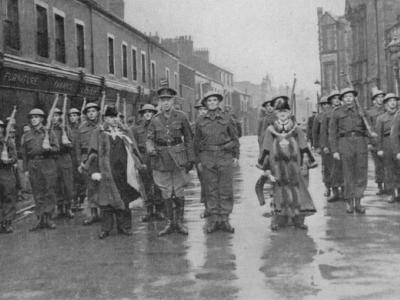
|
| ABOVE: Stand-down parade, Finkle St. Workington. Col. T. Dix-Perkin
with the Mayors of Workington (Councillor Lancaster) and Whitehaven (Councillor Harrison). |
This 5th Workington HG battalion, which by the middle of 1944 had a strength of 104 Officers
and 1679 Other Ranks, was stood down on the 3rd December 1944 with a 450 - strong
parade down Oxford Street, alongside the 4th (Cockermouth) and 6th (Whitehaven) HG battalions.
Home | Contents |
Workington | Links |
E-Mail | Home-Guard II

 Battalion Headquarters were initially located in Workington's Drill-Hall, then moved to No:5, Senhouse Terrace on Station Road when the 8th Battalion of the Border Regiment took over the Drill-Hall. BHQ was moved to more suitable premises in March 1942, taking up residence in the Wesleyan School behind the Methodist Church in South William St and staying there until stand-down in 1944. 'C'-Company continued to use No:5 Senhouse Terrace as a company office and Quartermaster's Stores.
Battalion Headquarters were initially located in Workington's Drill-Hall, then moved to No:5, Senhouse Terrace on Station Road when the 8th Battalion of the Border Regiment took over the Drill-Hall. BHQ was moved to more suitable premises in March 1942, taking up residence in the Wesleyan School behind the Methodist Church in South William St and staying there until stand-down in 1944. 'C'-Company continued to use No:5 Senhouse Terrace as a company office and Quartermaster's Stores.



